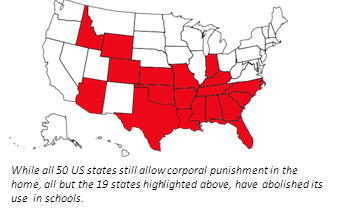
Corporal punishment is currently legal in all 50 US states. This means that a parent can spank his/her child as a form of discipline, so long as the force used is “reasonable”.
What is considered reasonable, however, varies from state to state. Generally speaking though, the line between corporal punishment and child abuse is considered to be crossed, when the punishment results in visible injury.
Studies have shown, overwhelmingly, that corporal punishment does not work, and can in fact have the opposite effect. Despite this compelling evidence, approximately 60% of adults still approve of its use as a disciplinary measure. For many kids, the parent’s anger or disapproval is more of a punishment for the child than the spanking that goes along with it.
Currently, 38 nations have enacted a full ban on all corporal punishment. The United States is not one of them. It is ironic that we scold our children for hitting other children on the playground, while slapping their hand to make our point.
Here are a few alternative strategies. For more detailed information click here.
- Establish a few firm rules that your child can understand.
- Give clear, simple directions. Reward positive behaviors.
- Punish immediately and consistently, but not frequently.
- Don’t set your kids up for failure.
- Use a natural consequence of the misbehavior
- Ignore misbehavior that is not harmful.
- Find out what is punishing and what is rewarding for YOUR child.
- Use “Time-Out” and remember talk with your child after the time-out. Make sure they understand the act and the consequence.
It’s important to remember that rewarding a child’s good behavior, is MUCH more effective than punishing bad behavior. Find out what motivates your child.
If you suspect a child is being abused or neglected, or if you are a child who is being maltreated, contact Toll-Free: 1-855-4LA-KIDS (855) 452-5437 or go here to learn more.




